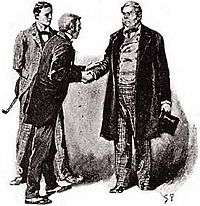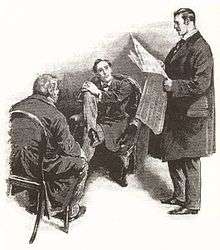The Red-Headed League
"The Red-Headed League" is one of the 56 Sherlock Holmes short stories written by Sir Arthur Conan Doyle. It first appeared in The Strand Magazine in August 1891, with illustrations by Sidney Paget. Conan Doyle ranked "The Red-Headed League" second in his list of his twelve favourite Holmes stories.[1] It is also the second of the twelve stories in The Adventures of Sherlock Holmes, which was published in 1892.
| "The Red-Headed League" | |
|---|---|
 Duncan Ross, Vincent Spaulding, and Jabez Wilson, 1891 illustration by Sidney Paget | |
| Author | Arthur Conan Doyle |
| Series | The Adventures of Sherlock Holmes |
| Publication date | 1891 |
| Followed by | "A Case of Identity" |
Plot summary

Jabez Wilson, a London pawnbroker, comes to consult Sherlock Holmes and Doctor Watson. While studying this prospective client, both Holmes and Watson notice his red hair, which has a distinct flame-like hue. Wilson tells them that some weeks before, his young assistant, Vincent Spaulding, urged him to respond to a newspaper want-ad offering highly-paid work to only red-headed male applicants. The next morning, Wilson had waited in a long line of fellow red-headed men, was interviewed and was the only applicant hired, because none of the other applicants qualified; their red hair was either too dark or too bright, and did not match Wilson's unique flame colour.
Wilson tells Holmes that his business has been struggling. Since his pawn shop did most of its business in the evenings, he was able to vacate his shop for short periods in the afternoon, receiving £4 a week for several weeks (equal to £440/week today);[2] the work was obviously useless clerical work in a bare office, only performed for nominal compliance with a will, whereupon he was made to copy the Encyclopædia Britannica. Wilson learned much about the subjects starting with the "A" section and looked forward to getting into the "B" section. One morning, a sign on the locked office door inexplicably announced that "THE RED-HEADED LEAGUE IS DISSOLVED"—Oct. 9, 1890."
Wilson went to the landlord, who said that he had never heard of Duncan Ross, the person who managed the league office. The landlord did remember the tenant with scarlet hair and gives him a card which directs Wilson to an artificial knee company. Wilson concludes by expressing his frustration at losing the £4 a week.
Watson and Holmes laugh at Wilson because of the ridiculous situation, but Holmes assures him that by Monday they will solve the case. Wilson leaves after having given the detective a description of Spaulding; Holmes decides to go and see Spaulding, whom Holmes notices has dirty trouser knees. Holmes then taps on the pavement in front of Wilson's shop. With the case solved, he calls Police Inspector Jones and Mr. Merryweather, a director of the bank located next door.
The four hide themselves in the bank vault, waiting in the dark for over an hour until two men emerge from a tunnel cut into the vault's floor and are captured. They are John Clay, who has a long history of criminal activity already, and his helper Archie. Under the aliases of Spaulding and Ross, they had contrived the 'Red-Headed League' rigmarole to keep Wilson out of his shop while they dug a tunnel in the basement to reach the vault. Although paying Wilson £4 a week was expensive, it was a pittance compared to the shipment of gold coins they were planning to steal.
Back at Baker Street, Holmes explains to Watson how he solved the case, applauding Clay's creativity and regretting that such a mind has been wasted on crime.
Analysis
The dates given in the story do not match the characters' descriptions of time passing. The date that Wilson sees the advertisement is 27 April 1890 and he has been at work for 8 weeks and says "Just two months ago."[3] Thus that happened by the end of June. However, the story begins by describing the Holmes's meeting with Wilson as being on "one day in the autumn of last year" and the date on the door telling of the League being dissolved is that of 9 October 1890, six months after the ad was placed.
Dorothy L. Sayers analyzed this discrepancy and claims that the dates must have been 4 August and 4 October respectively.[4]
Publication history
"The Red-Headed League" was first published in the UK in The Strand Magazine in August 1891, and in the United States in the US edition of the Strand in September 1891.[5] The story was published with ten illustrations by Sidney Paget in The Strand Magazine.[6] It was included in the short story collection The Adventures of Sherlock Holmes,[6] which was published in October 1892.[7]
Adaptations
Film and television
A 1921 short film was adapted from the story as part of the Stoll film series featuring Eille Norwood as Sherlock Holmes.[8]
The story was adapted for a 1951 TV episode of Sherlock Holmes starring Alan Wheatley as Holmes.[9]
The first American television adaptation of the story was in the 1954–1955 television series Sherlock Holmes starring Ronald Howard.
An adaptation of "The Red-Headed League" was used for an episode of the 1965 television series Sherlock Holmes starring Douglas Wilmer as Holmes and Nigel Stock as Watson, with Toke Townley as Jabez Wilson.[10]
In the 1985 television adaptation starring Jeremy Brett, the scheme was masterminded by Professor Moriarty and Clay is Moriarty's star pupil of crime.
In the NHK puppetry television series Sherlock Holmes, Jabez Wilson is a pupil of Beeton School as well as Holmes and Watson and is invited to the Red-Headed Club by his senior Duncan Ross. But strangely enough, what he does in the club is painting balls, stones and bottles red. Holmes suspects that it is a means of Ross who wants to make Wilson stay away from a certain place.[11]
Radio
Edith Meiser adapted the story as the third episode of the radio series The Adventures of Sherlock Holmes, which aired on 5 January 1931, starring Clive Brook as Sherlock Holmes and Leigh Lovell as Dr. Watson.[12] Other episodes adapted from the story aired on 24 May 1933 (with Richard Gordon as Holmes and Lovell as Watson)[13] and 8 February 1936 (with Gordon as Holmes and Harry West as Watson).[14]
Edith Meiser also adapted the story for the radio series The New Adventures of Sherlock Holmes with Basil Rathbone as Holmes and Nigel Bruce as Watson. The episode aired on 27 October 1940.[15] Other episodes adapted from the story aired on 28 May 1943,[16] and on 2 June 1947 (with Tom Conway as Holmes and Bruce as Watson).[17] The story was also read by Basil Rathbone in a 1966 recording released by Caedmon Records.
A radio adaptation starring Carleton Hobbs as Holmes and Norman Shelley as Watson aired on the BBC Home Service in 1953.[18] Hobbs and Shelley also played Holmes and Watson respectively in a 1957 radio adaptation on the BBC Home Service,[19] and a 1964 radio adaptation on the BBC Light Programme.[20]
John Gielgud played Holmes and Ralph Richardson played Watson in a radio adaptation of "The Red-Headed League" which aired on 19 October 1954 on the BBC Light Programme. The production also aired in January 1955 on NBC radio and in May 1956 on ABC radio.[21]
A radio adaptation aired on 26 April 1977, on the series CBS Radio Mystery Theater. Kevin McCarthy was the voice of Holmes.[22]
An adaptation aired on BBC radio in June 1978, starring Barry Foster as Holmes and David Buck as Watson. It was adapted by Michael Bakewell.[23]
"The Red-Headed League" was dramatised for BBC Radio 4 in 1990 as part of Bert Coules' complete radio adaptation of the canon, starring Clive Merrison as Holmes and Michael Williams as Watson. It also featured James Wilby as Vincent Spaulding.[24]
A 2014 episode of the Imagination Theatre radio series The Classic Adventures of Sherlock Holmes was adapted from the story, and starred John Patrick Lowrie as Holmes and Lawrence Albert as Watson.[25]
Stage
The story, along with "The Disappearance of Lady Frances Carfax", "The Adventure of the Empty House", and "The Adventure of Charles Augustus Milverton", provided the source material for the play The Return of Sherlock Holmes.
See also
References
- Notes
- Temple, Emily (22 May 2018). "The 12 Best Sherlock Holmes Stories, According to Arthur Conan Doyle". Literary Hub. Retrieved 6 January 2019.
- UK Retail Price Index inflation figures are based on data from Clark, Gregory (2017). "The Annual RPI and Average Earnings for Britain, 1209 to Present (New Series)". MeasuringWorth. Retrieved 2 February 2020.
- Arthur Conan Doyle, "The Penguin Complete Sherlock Holmes" (Penguin 1987) pp.178
- Dorothy L. Sayers, "The Dates in The Red-Headed League", reprinted in 17 Steps to 221B Baker Street (George Allen and Unwin, 1967) pp.57-67. Sayers' analysis is somewhat tongue-in-cheek In the Foreword to Unpopular Opinions, in which this essay also appeared, Sayers says that the "game of applying the methods of the Higher Criticism to the Sherlock Holmes canon... has become a hobby among a select set of jesters here and in America."
- Smith (2014), p. 44.
- Cawthorne (2011), p. 56.
- Cawthorne (2011), p. 54.
- Eyles, Alan (1986). Sherlock Holmes: A Centenary Celebration. Harper & Row. p. 130. ISBN 0-06-015620-1.
- Eyles, Alan (1986). Sherlock Holmes: A Centenary Celebration. Harper & Row. p. 136. ISBN 0-06-015620-1.
- Eyles, Alan (1986). Sherlock Holmes: A Centenary Celebration. Harper & Row. p. 138. ISBN 0-06-015620-1.
- Shinjiro Okazaki and Kenichi Fujita (ed.), "シャーロックホームズ冒険ファンブック Shārokku Hōmuzu Boken Fan Bukku", Tokyo: Shogakukan, 2014, pp. 43-45. (Guidebook to the show)
- Dickerson (2019), p. 25.
- Dickerson (2019), p. 53.
- Dickerson (2019), p. 73.
- Dickerson (2019), p. 96.
- Dickerson (2019), p. 129.
- Dickerson (2019), p. 229.
- De Waal, Ronald Burt (1974). The World Bibliography of Sherlock Holmes. Bramhall House. p. 385. ISBN 0-517-217597.
- De Waal, Ronald Burt (1974). The World Bibliography of Sherlock Holmes. Bramhall House. p. 386. ISBN 0-517-217597.
- De Waal, Ronald Burt (1974). The World Bibliography of Sherlock Holmes. Bramhall House. p. 391. ISBN 0-517-217597.
- Dickerson (2019), pp. 284, 287.
- Payton, Gordon; Grams, Martin, Jr. (2015) [1999]. The CBS Radio Mystery Theater: An Episode Guide and Handbook to Nine Years of Broadcasting, 1974-1982 (Reprinted ed.). McFarland. p. 205. ISBN 9780786492282.
- Eyles, Alan (1986). Sherlock Holmes: A Centenary Celebration. Harper & Row. p. 140. ISBN 0-06-015620-1.
- Bert Coules. "The Adventures of Sherlock Holmes". The BBC complete audio Sherlock Holmes. Retrieved 12 December 2016.
- Wright, Stewart (30 April 2019). "The Classic Adventures of Sherlock Holmes: Broadcast Log" (PDF). Old-Time Radio. Retrieved 14 June 2020.
- Sources
- Cawthorne, Nigel (2011). A Brief History of Sherlock Holmes. Running Press. ISBN 978-0762444083.
- Dickerson, Ian (2019). Sherlock Holmes and His Adventures on American Radio. BearManor Media. ISBN 978-1629335087.
- Smith, Daniel (2014) [2009]. The Sherlock Holmes Companion: An Elementary Guide (Updated ed.). Aurum Press. ISBN 978-1-78131-404-3.
External links


